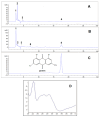Phytochemical Analysis and Antioxidant, Antimicrobial, and Antibiofilm Effects of a New Himalayan Lichen Placidium deosaiense Usman and Khalid Growing in Pakistan
- PMID: 39456982
- PMCID: PMC11508212
- DOI: 10.3390/ijms252011203
Phytochemical Analysis and Antioxidant, Antimicrobial, and Antibiofilm Effects of a New Himalayan Lichen Placidium deosaiense Usman and Khalid Growing in Pakistan
Abstract
Phytochemical composition and antimicrobial, antibiofilm, and antioxidant effects of a newly described Himalayan lichen Placidium deosaiense Usman and Khalid growing in Pakistan were investigated. HPLC-DAD methods were used for identification of secondary metabolites in acetone and methanol extracts. The total phenolics content was measured using a spectrophotometric method. The study investigated the antioxidant (DPPH-scavenging activity assay and reducing-power assay), antibacterial (minimum inhibitory concentration (MIC) and minimum bactericidal concentration (MBC)), and antibiofilm (inhibition of biofilm formation and reduction in mature biofilm) activities of extracts of the lichen P. deosaiense and isolated parietin. The chemical constituents olivetol, olivetolic acid, haematommic acid, fallacinol, and parietin were identified as major compounds in the tested extracts of the lichen. Parietin was isolated from the acetone extract on a separation column. The methanol extract had higher values of TPC (21.67 mg GAE/g) than the acetone extract. Isolated parietin showed the best antioxidant activity measures, according to the DPPH-scavenging activity assay (IC50 = 51.616 μg/mL) and reducing-power assay. Although the extracts showed the best antibacterial activity (especially against Proteus mirabilis ATCC 12453), parietin demonstrated superior antibiofilm activity (especially against Staphylococcus aureus ATCC 25923). This is the first report on the phytochemical composition of the lichen Placidium deosaiense and the first description of the chemical composition of some of the 45 species of the genus Placidium. This research will pave the way for further exploration of new activities of this lichen and its metabolites, which are important for medicine and pharmacy.
Keywords: Placidium deosaiense; antibiofilm; antimicrobial; antioxidant; phytochemical analysis.
Conflict of interest statement
The authors declare no conflicts of interest.
Figures




References
-
- Kocovic A., Jeremic J., Bradic J., Sovrlic M., Tomovic J., Vasiljevic P., Andjic M., Draginic N., Grujovic M., Mladenovic K., et al. Phytochemical Analysis, Antioxidant, Antimicrobial, and Cytotoxic Activity of Different Extracts of Xanthoparmelia stenophylla Lichen from Stara Planina, Serbia. Plants. 2022;11:1624. doi: 10.3390/plants11131624. - DOI - PMC - PubMed
MeSH terms
Substances
LinkOut - more resources
Full Text Sources
Medical
Molecular Biology Databases

